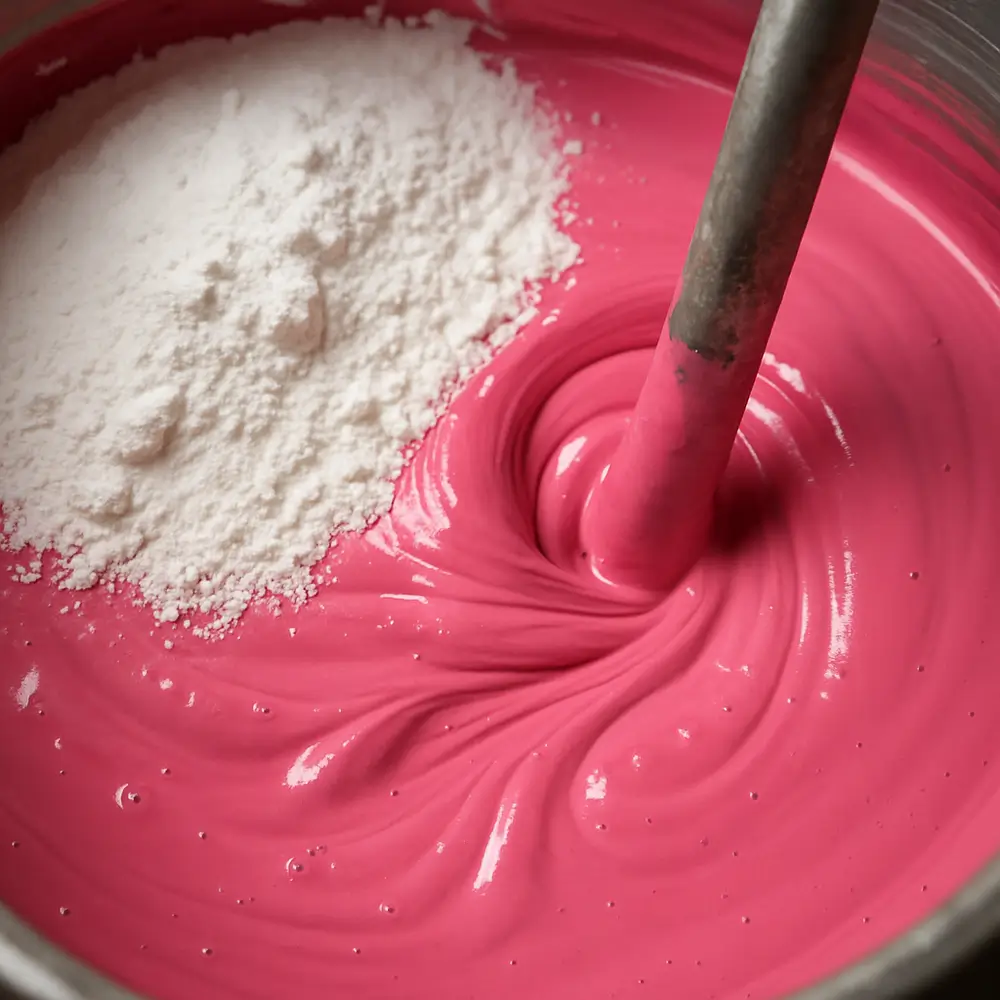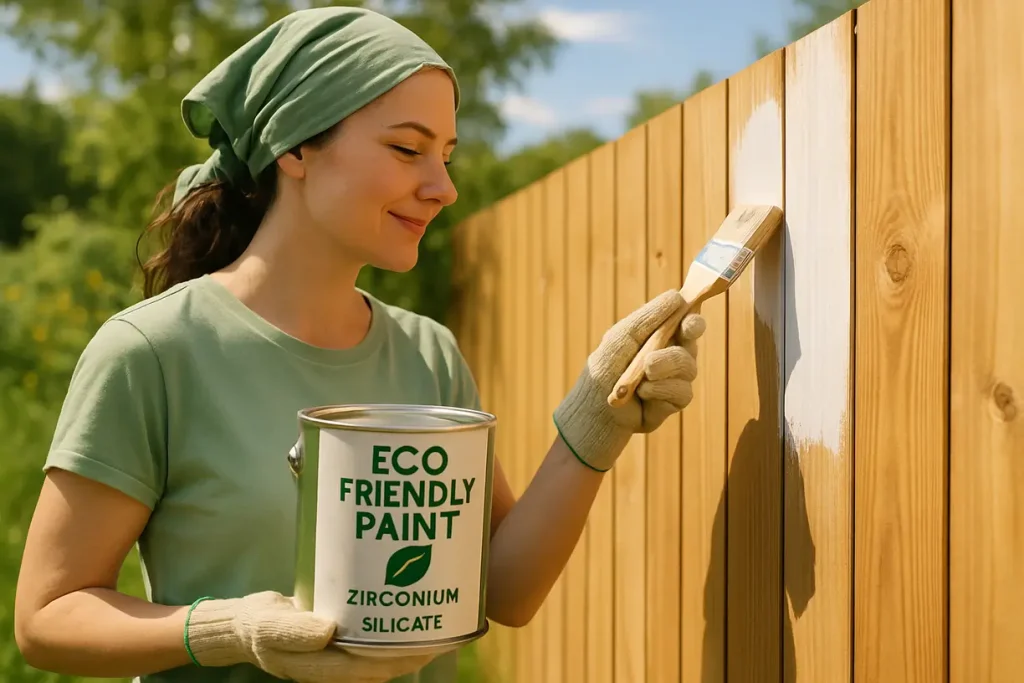Paint quality often raises concerns for manufacturers and purchasing managers within the industry. In today’s competitive marketplace, they need products that stand up to rigorous performance standards and effectively resist environmental challenges. So, how can businesses enhance the durability and effectiveness of their paint offerings? This article dives into how zirconium silicate serves as a potent solution, significantly improving paint performance and longevity. Backed by extensive industry research and expert testimonials, this guide provides actionable insights for decision-makers looking to optimize their paint formulations for better quality and greater market acceptance.

This image shows zirconium silicate blended into a vibrant paint mix, demonstrating its use in enhancing paint formulations.
How Does Zirconium Silicate Affect Paint Formulation?
Understanding the role of zirconium silicate in paint chemistry is crucial for manufacturers aiming to produce high-quality coatings. Zirconium silicate is a mineral compound derived from the thermal processing of zirconium dioxide and silicon dioxide. Its unique molecular structure enables it to act as a powerful additive in various formulations. One of the most notable advantages of incorporating this compound is its ability to enhance the opacity of the paint. This is especially vital in sectors where color visibility is critical.
Here’s the deal: with higher opacity levels, less paint is required to achieve the desired color coverage, leading to significant cost savings for manufacturers. This feature not only enhances the aesthetic appeal of the finished product but also ensures that companies use materials more efficiently, thereby minimizing waste and costs. In an industry where raw material prices can fluctuate significantly, the strategic use of an effective additive can serve as a financial buffer.
In addition to improving opacity, this compound contributes to stability within the paint formulation. It helps maintain the product’s consistency and ensures a smooth application process. Unlike other additives that may separate or settle during storage, zirconium silicate maintains a homogenous mixture, which simplifies handling during production and application.
Focusing on its interaction with other components, zirconium silicate proves to be versatile, enhancing compatibility with various types of binders and solvents commonly used in paint formulations. This versatility is particularly valuable in the development of customized coatings. As manufacturing processes increasingly demand flexibility, the ability to incorporate a dynamic additive means companies can avoid compatibility issues that might otherwise hinder production.
| Property | Zirconium Silicate | Other Common Additives |
|---|---|---|
| Opacity | High | Varies |
| Stability | Excellent | Moderate to low |
| Compatibility with Binders | High | Varies |
What Benefits Does Zirconium Silicate Provide for Paint Performance?
The benefits of including zirconium silicate in paint formulations extend beyond mere aesthetics. One of its primary advantages is enhancing abrasion resistance, a factor that is crucial in both industrial and decorative applications. Paints containing this additive are less prone to scratching and wear, which is particularly important in environments with high foot traffic or heavy machinery operation.
You might be wondering why this matters—better abrasion resistance translates to longer-lasting finishes, directly reducing the need for frequent repainting. In sectors like manufacturing and construction where surfaces face constant wear, this durability not only keeps products looking new but also elevates the overall value proposition for customers.
Another key benefit lies in improving color retention over time. Many paints fade with prolonged exposure to ultraviolet (UV) light, but the inclusion of this compound helps maintain vibrant colors, even under harsh environmental conditions. This capability is especially beneficial for exterior applications where long-lasting aesthetics are vital. As a result, clients can enjoy surfaces that remain visually appealing for a longer duration, enhancing their overall satisfaction and loyalty.
When it comes to UV resistance, coatings formulated with zirconium silicate can better withstand continuous sun exposure, providing a valuable protective layer against fading and degradation. This resistance not only preserves the paint’s appearance but also supports the longevity of the underlying surface. By minimizing the effects of sun damage, companies help to protect investments made in exterior structures, thus safeguarding revenue streams.
Lastly, the additive’s role in enhancing weather resistance is paramount. It aids in forming a resilient barrier against moisture and other climatic factors that can degrade paint performance over time. This feature not only improves durability but also reduces maintenance costs for end-users, leading to higher satisfaction rates.
| Benefit | Impact on Paint |
|---|---|
| Abrasion Resistance | Longer-lasting finishes |
| Color Retention | Vibrant, enduring colors |
| UV Resistance | Prevents fading |
| Weather Resistance | Enhances durability |

This image illustrates the key benefits of zirconium silicate in paint, including durability, UV resistance, and color retention.
How Does Zirconium Silicate Contribute to Paint Durability?
Durability is a critical aspect of paint formulations, affecting everything from customer satisfaction to production costs. Zirconium silicate plays a vital role in promoting adhesion, which is essential for creating strong bonds between the paint and the substrate it is applied to. This enhanced adhesion means that there are fewer instances of peeling, flaking, or chipping, common issues that plague lower-quality paints.
Here’s the key takeaway: strong adhesion means longer-lasting finishes that support customer satisfaction and brand loyalty. This commitment to durability is particularly important for exterior applications, where weather and environmental factors pose significant risks. By using zirconium silicate, manufacturers can elevate the performance of their paint products to new heights.
Moreover, this compound accommodates temperature variations effectively. Paints formulated with this additive can better withstand extreme hot or cold conditions without degrading, cracking, or losing their integrity. With climates becoming increasingly unpredictable, products that remain effective across a range of temperatures are not just beneficial; they are essential.
Long-term performance, another critical factor, is enhanced due to the molecular properties of zirconium silicate. Companies can expect that their products will maintain high performance levels over time, which reduces the risk of needing to address customer complaints or product failures. This not only preserves the company’s reputation but also minimizes costs related to warranty claims and reworks.
| Durability Factor | Impact |
|---|---|
| Adhesion | Reduced peeling/flaking |
| Temperature Resistance | Minimizes cracking |
| Longevity | Extended product lifespan |
In What Types of Paints Is Zirconium Silicate Most Effective?
The versatility of zirconium silicate is evident across various categories of paint. In industrial coatings, where durability is paramount, this additive can significantly enhance protective coatings used on machinery and infrastructure. Here’s the insight: incorporating it into these formulations can lead to products that perform exceptionally well in demanding environments.
In decorative paints, the benefits become even clearer. Aesthetic appeal is essential in this category, and the capacity of zirconium silicate to maintain color vibrancy and finish quality is invaluable. Whether in residential or commercial settings, paints must not only protect but also look good. The superior finish provided by this compound allows manufacturers to deliver products that meet and exceed customer expectations.
Further supporting its effectiveness, case studies have shown substantial performance improvements in both industrial and decorative applications when this additive is included in formulations. Companies that have embraced this compound report fewer complaints and higher customer retention rates. This positive feedback loop reinforces the value proposition of using zirconium silicate within diverse paint products.
Moreover, its adaptability extends to specialty paints as well. This includes coatings used in marine, automotive, and high-performance settings where additional features such as corrosion resistance are necessary. Acquiring flexibility in formulation is a game-changer, allowing businesses to respond quickly to market changes or specialized client demands.
| Paint Type | Application Type | Effectiveness |
|---|---|---|
| Industrial Coatings | Machinery & Structures | High durability |
| Decorative Paints | Residential & Commercial | Superior appearance |
What Are the Environmental Considerations of Using Zirconium Silicate?
From an environmental perspective, using zirconium silicate brings several advantages that align well with the global push toward sustainability. This additive is characterized by a low ecological footprint compared to many traditional options. Importantly, it is non-toxic and does not release harmful emissions during the application process.
This is a major point to emphasize—embracing environmentally friendly materials can significantly enhance a company’s reputation. Businesses focusing on sustainability can leverage zirconium silicate to market their products as eco-conscious choices. This positioning resonates with environmentally aware consumers and can provide a competitive edge.
Furthermore, this compound is typically in compliance with various regulations related to environmental safety. For companies committed to sustainable practices, using materials that adhere to local and international regulations paves the way for smoother market access and increased credibility. Aligning with regulatory standards is not only beneficial for protecting public health but also strengthens brand integrity.
When considering environmental impacts, it’s essential to highlight that the use of zirconium silicate contributes to increasing the longevity of paint applications. Durable paints require less frequent reapplication, significantly reducing waste generation. This sustainability aspect allows manufacturers to not only protect their bottom line but also exhibit their commitment to responsible production.
| Environmental Impact | Zirconium Silicate | Traditional Additives |
|---|---|---|
| Toxicity | Non-toxic | Varies |
| Emission Levels | Low | Higher |
| Waste Reduction | Promotes longevity | Frequent repaints needed |

An eco-friendly paint enthusiast uses zirconium silicate paint in an outdoor setting.
How Can B2B Buyers Select Quality Zirconium Silicate?
Choosing quality zirconium silicate requires careful scrutiny from B2B buyers. A fundamental aspect is evaluating purity levels. Higher purity generally correlates with better performance in paint applications, maximizing the intended benefits of the additive. Buyers should always ask suppliers for documentation concerning purity tests; this diligence empowers informed purchasing decisions that can significantly impact formulation success.
What’s the next step? Establish a relationship with reliable suppliers. Researching their reputation within the industry provides insight into their reliability. Seeking testimonials and case studies from other clients can offer invaluable information about product performance and customer service. A dependable supplier not only guarantees consistent quality but also offers support that can help resolve any issues that may arise during the formulation process.
Another critical evaluation point is product certifications. Verifying compliance with industry standards and regulations gives buyers peace of mind regarding the reliability and safety of the materials they are considering. Certificates of compliance and safety data sheets can serve as valuable proof of quality, ensuring that buyers invest in materials that meet or exceed expected industry benchmarks.
While assessing these elements, pricing is also a crucial factor. It is essential to weigh the costs against the quality of the product. Buyers should avoid sacrificing quality for a lower price; the long-term savings derived from superior materials often outweigh initial costs.
| Selection Criteria | Importance |
|---|---|
| Purity Levels | Direct impact on performance |
| Supplier Reliability | Consistency in quality |
| Product Certifications | Assurance of compliance |
| Pricing | Balance between cost and quality |
What Are Common Misconceptions About Zirconium Silicate in Paint?
Despite its established benefits, several misconceptions surround zirconium silicate and its role in paint formulations. One notable belief is that this additive is too expensive for widespread application. However, while its initial price point may be higher compared to some alternatives, the long-term savings associated with its use often justify the investment, ultimately serving the bottom line well.
So, what’s the reality? Zirconium silicate can be a cost-effective solution when you consider its impact on overall lifespan and performance of paint products. Another prevalent myth suggests that this additive cannot be utilized in conjunction with other materials. In reality, it enhances the performance of various binders, pigments, and solvents, proving to be a valuable companion in diverse formulations.
A final misconception revolves around the idea that zirconium silicate is a “magic bullet” for improving paint quality. While it does provide significant benefits, it should be part of a well-rounded formulation strategy that includes complementary additives and quality ingredients for optimal results.
| Misconception | Clarification |
|---|---|
| Too expensive | Long-term savings justify expense |
| Incompatible with additives | Complements diverse formulations |
| A magic bullet | Must be used with other components |
How Does Zirconium Silicate Affect the Cost of Paint?
The cost implications of incorporating zirconium silicate into paint formulations should not be overlooked. Initially, it may appear that using this additive increases production costs compared to alternative ingredients. However, the resulting improvements often justify the expense over the product’s lifetime. Efficient use of zirconium silicate can lead to reduced overall material consumption since it enhances opacity and durability, allowing manufacturers to use less product while achieving better results.
Here’s a key takeaway: smart investments today translate into significant savings tomorrow. Companies can also expect fewer customer complaints and reduced frequency of repainting, which contributes to substantial long-term savings. As the market becomes more competitive, the ability to provide high-quality, durable products can yield a significant advantage.
Moreover, enhanced performance facilitated by zirconium silicate allows manufacturers to explore premium pricing strategies. When clients perceive a product as offering superior quality and longevity, they are often willing to pay a bit more. This ability to present paint products as high-end can elevate a company’s market positioning, ultimately leading to increased profitability.
| Cost Factor | Impact of Zirconium Silicate |
|---|---|
| Initial Investment | Higher than some additives |
| Material Efficiency | Reduces overall usage |
| Long-term Savings | Fewer reapplications |
What Are the Challenges of Using Zirconium Silicate in Paint?
While zirconium silicate offers numerous advantages, there are also challenges associated with its use in paint formulations. Compatibility issues can arise when mixing this additive with certain binders or pigments, which could lead to undesirable effects on the final product. To mitigate this risk, manufacturers are encouraged to conduct comprehensive testing during the formulation phase. These preliminary tests allow for identification of any potential issues early on, enabling proactive resolution.
What else should you know? Troubleshooting is essential for optimizing product formulation. Engaging in dialogues with suppliers and experts in the field can provide insights and advice that facilitate smoother integration of zirconium silicate into paint formulations.
Another consideration is the mixing and stirring processes, which can directly impact the performance of the final paint product. Improper blending techniques may lead to settling or uneven consistency, negatively affecting application quality. Therefore, careful attention should be paid to the equipment and methods used during manufacturing to achieve the best possible results.
| Challenge | Solution |
|---|---|
| Compatibility Issues | Conduct test formulations |
| Mixing Difficulties | Use proper stirring techniques |
How Can Companies Optimize Their Use of Zirconium Silicate?
For companies looking to capitalize on the benefits of zirconium silicate, optimizing its use in paint formulations requires strategic planning and continuous improvement. One best practice is to adjust formulations based on specific application needs. Evaluating the desired performance attributes allows companies to fine-tune the amount of this compound used, which can enhance performance tailored to particular end-use scenarios.
Here’s the plan: Regularly reviewing and assessing formulations for maximum efficiency can significantly impact product quality. Staying informed about new research, technological advances, and industry trends enables businesses to adapt and improve continuously.
Collaboration with suppliers can also provide significant benefits. Regular feedback and engagement can yield valuable insights that inform product development and operational improvements. Not only does this relationship help in optimizing formulations, but it can also lead to innovations that enhance product offerings.
Lastly, investing in ongoing training for staff in the latest techniques related to the use of zirconium silicate can ensure consistent high-quality outcomes. Building a knowledgeable workforce strengthens product quality and fosters a culture of excellence within the organization.
| Optimization Strategy | Benefits |
|---|---|
| Adjust Formulations | Tailors performance to specific needs |
| Stay Informed | Keeps products competitive |
| Supplier Collaboration | Generates valuable insights |
Conclusion
In summary, zirconium silicate offers significant advancements in paint performance and durability. Through its ability to improve opacity, resistance, and longevity, businesses can achieve superior results. The quantifiable benefits include reduced repainting frequency, improved customer satisfaction, and enhanced consumer loyalty.
Partnering with Global Industry means having access to high-quality zirconium silicate products that can meet the evolving needs of the paint industry. Take action today to enhance your paint formulations and empower your business to thrive in a competitive market.
FAQ Section
Q1: What is zirconium silicate? Zirconium silicate is a mineral compound that enhances paint properties by improving performance and durability.
Q2: How does zirconium silicate improve abrasion resistance? It forms a strong bond in the paint matrix, making it less susceptible to wear and tear.
Q3: Are there any health risks associated with zirconium silicate? Generally, zirconium silicate is considered safe when handled properly, but it’s best to follow safety guidelines.
Q4: Can zirconium silicate be used in all types of paints? While effective in many formulations, it’s essential to test compatibility based on specific paint types.
Q5: What should I look for when buying zirconium silicate? Prioritize purity, supplier reputation, and product certifications to ensure high quality.
